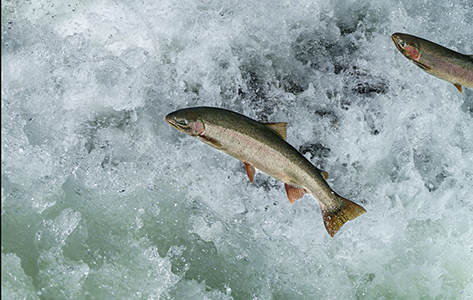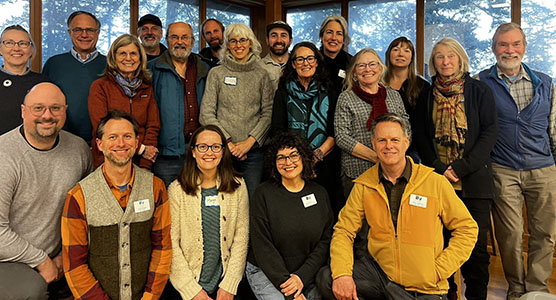— from Susan McBain, Orcas Issues reporter —
It’s complicated.
That’s the one thing that’s perfectly clear about the Port of Orcas’s draft Airport Master Plan, and the context in which it was developed. Browsing through the links on the Port’s web page on the Master Plan makes that obvious.
At their December 19 regular meeting, the four Port Commission members present—Brian Ehrmantraut, Greg Sawyer, Dwight Guss, and Steve Hopkins—spent a majority of their time trying to explain to those attending why the Master Plan is needed, what is required to be in it, and how it might translate into actual projects at the airport.
The Federal Aviation Administration’s (FAA’s) Airport Improvement Program (AIP) is a nationwide grant program, from which the Port currently is entitled to $150,000 per year. That amount is a significant chunk of the Port’s capital budget, and it can be carried over into following years to fund future projects in the Plan at a level of 90%. The last Master Plan was adopted in 1994 and amended in 2008. To continue being eligible for the program, the Port was required to develop a new Airport Master Plan projecting its possible activities for the next 20 years. Work began in fall of 2017 and should be complete in March 2019.
The Plan has three phases: less than 8 years, 8–19 years, and 20 years and beyond. In the current “preferred alternative,” the first phase includes development of the southeast area (the old dog park), relocation of part of the taxiway (no land acquisition required), rehabilitation and resurfacing of the runway with displaced thresholds (ends of the runway), relocation of a midfield connecting taxiway, purchase of a north Runway Protection Zone parcel that is available for sale, a land swap with Eastsound Water Users Association, and relocation of the fuel facility.
The version of the Plan presented at the September 19 Port Open House showed these projects as occurring in the second phase of the plan. However, because of the possibility of additional AIP funding and resulting savings for taxpayers, the Port elected to shift some projects into the first phase. Maps of the plans are available from the Port’s Master Plan page.
The FAA sets requirements for what the plan must include to qualify for the AIP. As Commission Chair Brian Ehrmantraut put it, “At the highest level this master plan is basically a list of the deficiencies [from FAA standards] at the airport, plus a few improvements that we want to do for our own purposes. Anything we do has to be on the list for us to get the 90% funding participation. It doesn’t mean we’re going to do all these things. It’s almost unimaginable how you’d go about fixing some of these deficiencies, like Mt. Baker Rd. They all have to be on the list, but there’s no project or schedule for a project until we actually decide to undertake one.”
Commissioner Greg Sawyer agreed. “A lot of the deficiencies that exist are real, but they’re so huge we’ll never be able to do them. Scary things like dealing with Mt. Baker Road or Brandt’s Landing—ridiculous! There are so many hurdles, including costs, property ownership, and many other factors. But they still have to be on the list. And we can make progress on some things like safety separation, and those are real things that you, the public, can have input on.”
“Right now all we’re saying is, would you like us to have the opportunity to continue applying for federal grant money? If we don’t finish the Master Plan, we lose that opportunity, and it’s hard to get it again. And we get a lot of really good things done here with that AIP money—like purchase of the southeast parcel and a new approach lighting system.”
“When we do plan a project, there is a public process,” Sawyer continued. “What there hasn’t been is anybody paying attention. We’ve had meetings for years, but there’s not much activity. So we don’t know that we’re not reaching you.”
Attending the meeting were Susan Malins, Sadie Bailey, Katie Wilkins, and Kimberly Secunda, who noted, “It’s so difficult to understand; we just see the list [of potential projects], and everyone worries about death by a thousand cuts. We don’t even know what we don’t know. It’s been explained but not understood. Please find a translator for us.”
Malins stated, “It has felt like you’ve been saying, these are our plans, this is what’s on paper, but we’re probably never going to do it. That’s really hard to figure out, to understand, and to trust. But transparency seem to be improving.”
Also discussed at the meeting were Tony Simpson’s departure date as airport manager (Feb. 24), plans for seeking a new airport manager, and plans to seek an alternative contractor for the wetlands mitigation project south of the airport to keep the project’s costs lower.
Previous Orcas Issues articles covered meetings held on June 5, July 26, and Sept. 12; those articles contain additional information on the Master Plan and process. The Port Commission’s next meeting is scheduled for Thursday, Jan. 10, at 4:30 in the Port conference room at the airport terminal.
**If you are reading theOrcasonian for free, thank your fellow islanders. If you would like to support theOrcasonian CLICK HERE to set your modestly-priced, voluntary subscription. Otherwise, no worries; we’re happy to share with you.**








Yes, as you say “It’s complicated” but your reporting, Susan, helps make it clearer all the same. Thank you.
Mailins makes a good point regarding an increase in transparency.
Commissioners’ comments seem sincere and pragmatic. Having a list of potentials (but not firm commitments or absolute requirements or firm promises to do A,B or C) in order to obtain funding strangely enough makes sense.
All in all, this update is clear even if questions remain—aren’t there always outstanding questions in multi-staged projects like this?
Seems like the commissioners and the community are both struggling to do their jobs professionally and transparently. Only by going through this process and learning about the deep reservoir of feelings are we all now clearer about the likelihood of what comes next. Isn’t that how it’s suppose to happen—this process and the intense community involvement, that is?
So no hard feelings as the process continues.
(Death by a thousand cuts? Attrition? Perhaps. And perhaps it’s a matter of perspective. Some things are inevitable, others aren’t. For those things that are “musts” as in “that must be done come hell or high water,” better that all concerned are at least present to help steer the course—that’s what’s happening, yes? Trust? A certain amount will always be required in every human interaction. We do it everyday with our very lives no less—and w/ complete strangers— when we get behind a wheel)
This report is very helpful. The Master Plan process is more nuanced and flexible than it originally appeared. The initial proposals seemed completely polarized:
Do nothing or do everything the Federal Aviation Administration wants. But FAA’s optimal plan is a poor fit for our rural airport that is constrained both geographically and by development that did not give airport planning the top priority. Thank-you Susan Malins, Sadie Bailey, Katie Wilkins, and Kimberly Secunda for attending and stimulating a conversation that is allowing us to find common ground.
Thank you for this article, which at least brings the issue of the Port Master Plan back into the attention of the Public.
To answer several of the Commissioners’ accusations that we-the-Public were not at meetings nor paying attention: How could we have known what to pay attention to, when we didn’t know what was in the works, including the Vegetation Obstruction Removal, which was signed off on in late 2013 and completed in 2017? That clearcut to the wetland got our attention – too late, alas, for Eastsound Swale – again.
As soon as we found out about the Master Plan buildout drawings in late June, we have been paying rapt attention ever since, and have been met with impatience and hostility concerning our many questions and concerns. A lot of answers continue to be circuitous; the same old stock answers – not direct answers to precise questions such as: In what ways did the Port try to represent our ecological constraints to the FAA? Meanwhile, the maximum buildout Master Plan marched ahead and now seems to be a “done deal.” The devil is in the details.
So please excuse our not knowing what the Port was, and is, up to: you can bet we’re paying close attention going forward. My big fear is that it’s already far too late; this train left the station way back in 2013. I’m incredulous that once again, the victims (we the Public) are blamed for the “crime” of not knowing, when the process itself is not set up to be transparent.
continued, next comment
continued from previous comment:
Some red flags for me from the Dec. meeting:
1. Less FAA money will be earmarked for environmentals, since the FAA regional manager determined that an EIS was not needed. Not needed to move our truck route through an important wetland or build a desalinization plant in wetland? No State oversight?
2. The explanations all sound reasonable to those new to this – but why should we trust Port assurances that these large-scale projects will never be built? We know how grant funded programs work, with Public Works as a prime example. Once the funding is given, there is NO TURNING BACK from maximum engineering and buildout.
3. The most egregious issues of all; noise, and dangers to those living below the flight paths – are not being addressed, even as chartered and private jets and helicopters are increasing.
4. the Port is considering Sam Gibbony for interim Port manager; does Council know?
5. Approving a 5% raise to the current manager, since he’s leaving in February.
Death by a thousand cuts is an accurate assessment of what’s going on. According to the Public Records Act, the Public’s hands are tied when it comes to knowing what’s actually going on; we are not privy to information regarding contract or construction bids in the works (not until after the contract is valid.)
I am happy to share my own citizen minutes taken from all meetings I’ve attended since July – I missed the rescheduled Oct. 25 meeting.
Well—what’s known is now known. Next? There’s always a next step! Go Sadie!
Thank you Susan McBain for agreeing to report on this… We need citizens’ coverage of our tax districts & you stepped up!
I like to be positive & said “transparency seems to be improving,” but please understand that we began with both Zero Transparency plus Seeming Misinformation from the port about the Master Plan update… so improvement in transparency is Purely Relative.
Much clarity has been achieved in 6 months through the activism of a few citizens, and the voluntary support of a community that clearly does Not want to enlarge its airport in order to receive greater funding and activity.
Public records requests have produced more information, yes indeed, as the law requires. A bit of this has been posted on the port website, but the port public information effort continues to be both inadequate and disingenuous. Please ask me for examples!
Hundreds of citizens signed a petition which asked for citizen involvement in the port advisory committee. Recently we requested citizen involvement in the interviews of a new General Manager. Yet the commissioners have responded to this & other requests only with the poker deadpan, & proceeded to do whatever they choose. No matter what the public thinks, without public input or involvement.
This is not clarification, this is stonewalling.
S. Malins- i get your points. I mostly agree with your assessments. I share the “implied” goals of yours, Janet Alderton’s, B Sadie, & Clark Cundy’s (fine Letter written back on August 9th), et al.. (on this matter).
But since we’re highlighting “transparency,” let’s take this a step further and make what’s been implied “completely” transparent, in the round, as is said in the world of Sculpture.
Let’s lay out precisely what the “no enlargement” contingency believes the other side stands for, wants and what’s driving them! No need for absolute proof and none will ever be afforded. Use your deductive powers and make a circumstantial case as to what the other side’s driving purpose and end goals are and let it be contested.
Put it all out on the table—not just our side which has been poeticized ad nauseam.
Adults don’t take offense and no singular view is sacrosanct. There are valid differences of opinion so instead of demonizing let’s make clear what the two visions are and why we think ours is better. Simple, yes?
I’m not used to this passive fear of calling things out for what they are—all this creepy indirectness. I spend each December & New Years in Asia—that’s their style. Ours is a little more “in your face” honest and less “social harmony at all cost” —
All cards on the table, now!. If we go down in flames how pathetic to lose to something vague & undefined. Real transparency now! #Be real!
Hint- consider the possibility that the feeling of being stymied and/or stonewalled is partly self-inflicted…who after all is allowing the other side to remain ambiguous, opaque, or undefined. If a side you oppose (opposition is a friendly word…get real) remains poorly defined, you’ve already handicapped the odds against yourself as it’s equivalent to negotiating against yourself…a fool’s error.
Negotiation 101 requires the positions of each side to be clearly defined and if one side’s strategy is to default to the above, “you” must define “them” yourself.
It may be that a silent majority of people on Orcas prefer their vision; want the mainland-like development and modern infrastructure. Are they evil or inherently wrong? Of course not. I may think it foolish longterm; still, it’s their vision— they may feel it better protects their financial investment and/or longterm appreciation. They may prefer not to be confrontational about it for fear of being misunderstood or maligned. The “squeaky wheel gets the grease” here means public attention, not necessarily indicative of a victorious outcome.
Stand in the shoes of your temporary adversary (tomorrow you may be on the same side of another issue with a pro-enlargement resident). We need to understand their position; define it in high resolution and see where the island’s opinion truly lies on this issue.
Allowing an opposing position to remain opaque is a loser’s (and loosing) strategy.